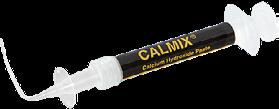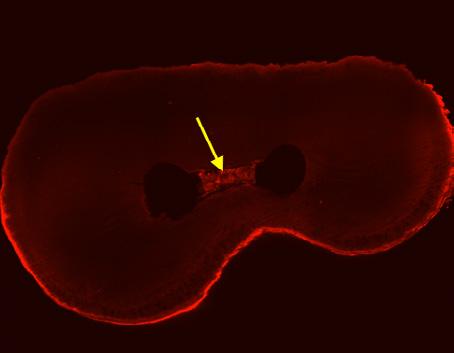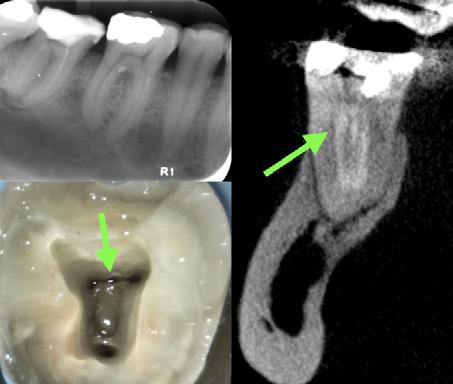
5 minute read
Calmix
TIME FOR A CHANGE
Dental Products Australia
Ready to try an improved calcium hydroxide medicament paste for endodontics?
CALMIX is an endodontic medicament that has a unique composition, ( a first for dentistry ), which is optimised for:
• Higher pH values than can be achieved in aqueous solutions. (CALMIX™ recorded ≥pH14) 1,2 . • Greater effectiveness against fungi than all other calcium hydroxide pastes. 3 • Broad spectrum effectiveness against highly resistant bacterial species, penetration of biofilms and inhibition of endotoxins. 3,4 ,6 • Release of hydroxide and calcium ions enhanced by a unique, patent-protected solvent. 5 • Excellent biocompatibility for soft tissues – independently Australian lab-tested. • Optimised viscosity for direct delivery into apical root canal system through ultrafine tips. • Non-staining formula using zirconium dioxide. • Enhanced radiopacity for detection on radiographs. • Improved removability by irrigation – methylcellulose free. 7 • Improved shelf life and won’t dry out – water-free.
History Traditional calcium hydroxide pastes for endodontics date back to the 1920s. These use water as the solvent, to which is added a thickener such as carboxy methylcellulose, and a radiopaque agent. Unfortunately, the low solubility of calcium hydroxide in water limits the maximum pH to 12.7, which further restricts the total release of hydroxyl ions that are responsible for the antimicrobial actions.1,2 Additionally, buffering of the pH by dentine greatly reduces the concentration of hydroxyl ions2,4 and compromises the overall effectiveness as an antimicrobial agent against bacterial species which can survive at highly alkaline pH conditions – up to pH 11.5.6,8
CALMIX™ – Better by design
CALMIX™ uses a novel biocompatible solvent to improve the release of Hydroxyl ions. Use of patented compositions consisting of co-polymerised polyethylene glycol (PEG) as the solvent enables ideal physical and chemical characteristics for clinical use.5 PEG in various forms is used in pharmaceutical products because of its high biocompatibility. It was discovered that optimised formulations of PEG were a superior solvent for calcium hydroxide and could dramatically elevate the pH that could be achieved by actively dissociating the compound into its ionic form. 5 This improved the release of hydroxyl ions by several orders of magnitude compared to water-based formulas.9
Release of ions
Hydroxyl ion release from CALMIX™ calcium hydroxide was designed for broad spectrum antimicrobial activity, penetration into biofilms, and effective against recalcitrant bacteria such as Enterococcus faecalis - which is often found in failed endodontic treatment. CALMIX™ has also been shown to inhibit endotoxins, reduce inflammation and dissolve organic tissues.3 When hydroxyl ions are released, calcium ions are also bio-available which contributes to hard tissue repair - essential for pulp capping and apexification – and potentially contributes to the healing of radicular cysts.10 Studies of the release of hydroxyl ions into the dentine of the root have demonstrated that higher pH values are achieved at the root canal walls and through the inner and middle parts of the root with CALMIX™ than with water-based calcium hydroxide pastes.9 Unlike compositions containing water, CALMIX™ can sustain the high pH over long periods of time without relapse, thereby providing a longer therapeutic effect and reducing the need for frequent re-dressing in longstanding lesions. However, the pH recorded on the external root surface is unaffected,11 indicating no adverse chemical effect on the cells of the periodontal ligament and no increase in post-operative discomfort. Calmix has been independently Australian lab-tested using ISO 10993-5 (2009) to be less cytotoxic than other commonly available formulations. Clinical Applications Calmix is suitable for use as an intracanal medicament for improved disinfection within areas of the root canal that are not easily accessible or instrumented eg: isthmuses and fins. (Figure 1) Calmix can also be used in vital pulp therapy as a pulp capping agent, and as a long-term dressing for apexification cases. Its enhanced radiopacity allows for easy identification on periapical radiographs and can assist in tracing the root canal morphology on 3D-imaging systems (Figure 2).

Figure 1: Laser fluorescence imaging shows isthmus area uninstrumented following mechanical instrumentation. Calmix within the canals provide a hostile environment to chemically debride and disinfect areas that are hard to reach. (Image courtesy of Kiran Kumar, Yu-Yao Teoh, Laurence J Walsh)
Figure 2: Enhanced radiopacity allows for easy tracing of canal morphology. 3D imaging showing a middle-mesial canal filled with Calmix for improved contrast and easy identification.

KEY POINTS: CALMIX™
• Independently tested to be less cytotoxic when tested against other calcium hydroxide medicaments. • Contains zirconium dioxide, a non-staining radiopaque agent. • Greater calcium hydroxide dissolution and release for higher pH than all other existing medicaments • Maintaining higher pH over longer periods of time - achieving greater and prolonged antimicrobial activity within the root canal system reducing the need for frequent re-dressing. • Greater release of calcium ions for hard tissue formation.
• Unique PEG co-polymer composition – no water or methylcellulose – does not dry out on a pad or in the syringe, ready to use with no mixing, and easily flowed into canals with very fine microtips. • Methylcellulose-free composition is easily removed prior to obturation.
REFERENCES 01 Athanassiadis B, Walsh LJ. Aspects of solvent chemistry for calcium hydroxide medicaments. Materials (Basel) 2017;10:1219. DOI:10.3390/ma10101219 PMID: 29065542 02 Teoh YY, Athanassiadis B, Walsh LJ. The influence of aqueous and PEG400 solvent vehicles on hydroxyl ion release from calcium hydroxide medicaments. Int Dent – Australasian edition. Vol 11, No 4. 03 Athanassiadis B, Abbott PV, Walsh LJ. The use of calcium hydroxide, antibiotics and biocides aantimicrobial medicaments in endodontics. Aust Dent J 2007;52(1 Suppl):S64-S82. 04 Athanassiadis B, Abbott PV, George N, Walsh LJ. In vitro study of the inactivation by dentine of some endodontic medicaments and their bases. Aust Dent J 2010; 55:298-305. 05 Australian patent 2012/286596. New Zealand patents 620382, 709691, and 728268. World patent WO 2013013275. European patent application EP 12818358.9. 06 Evans M, Davies JK, Sundqvist G, Figdor D. Mechanisms involved in the resistance of Enterococcus faecalis to calcium hydroxide. Int Endod J 2002;35:221-228. 07 Chou K, George R, Walsh LJ. Effectiveness of different intracanal irrigation techniques in removing intracanal paste medicaments. Aust Endod J 2014;40:21-25. 08 Walsh LJ, Athanassiadis B. The challenge of endodontic “superbugs” in clinical practice. Australasian Dental
Practice 2008;19:102-106. 09 Teoh YY, Athanassiadis B, Walsh LJ. Comparison of commercial calcium hydroxide pastes for prolonged antibacterial effect using a colourimetric assessment. Materials (Basel) 2018;11:348; DOI:10.3390/ma11030348. 10 Kontogiannis TG, Tosios KI, Kerezoudis NP. Effect of calcium hydroxide as intracanal medicament on the expression of caspase-9 located within the radicular cyst epithelium. Aust Endod J 2019;45:352-356. 11 Cai M, Abbott P, Salgado JC. pH changes in radicular dentine associated with calcium hydroxide and corticosteroid/antibiotic pastes. Aust Endod J 2018; DOI: 10.1111/aej.12280
Order Calmix through our website.
DR YU-YAO TEOH
Brisbane, Queensland Learn more on Dental Education Hub scan here.









